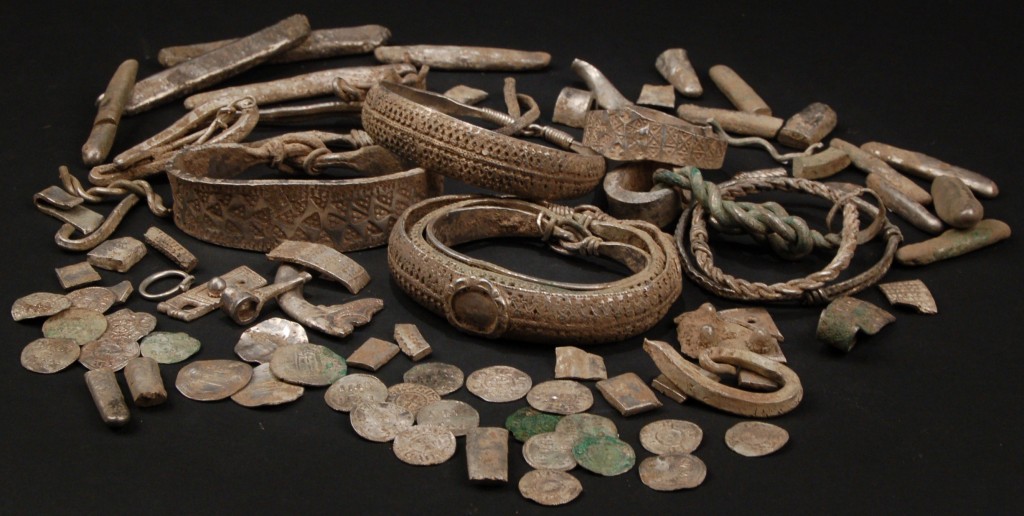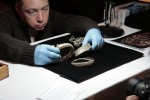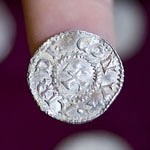Proving yet again that Britain is basically one giant buried treasure disguised by a thin layer of loam, another metal detector-wielding hobbyist has discovered a Viking hoard of 201 pieces of silver, including ingots, coins and arm rings, in a well-preserved lead container. It’s the fourth largest Viking hoard ever found.

Darren Webster found the hoard in September near the village of Silverdale in North Lancashire. When the metal detector his wife had given him for Christmas went off, he dug down 18 inches to find what turned out to be a lead pot. At first he thought it was just a sheet of lead, but when he picked it up silver fell out and he saw that the lead had been folded into a container. He reported the find to the authorities and the recovered hoard went to the British Museum for expert analysis.
 Yesterday the British Museum unveiled the hoard to the press in anticipation of the coroner’s inquest to determine its treasure status next week. The final tally is 27 coins, 10 arm rings from various Viking periods, two rings (for fingers), 14 ingots, six brooch fragments, a wire braid and 141 pieces of hacksilver (chopped up bits of silver from arm rings and ingots that were used as bullion currency). The coins date the hoard to around 900 A.D. They are a mixture of Anglo-Saxon, Viking, Frankish and Islamic coins, including coins of Alfred the Great, first self-described King of the Anglo-Saxons, his nephew Alwaldus, the Viking king of East Anglia Guthrum (who was defeated in battle by Alfred, converted to Christianity, took the baptismal name Athelstan with Alfred as his godfather) and one mysterious Viking ruler previously unknown to us.
Yesterday the British Museum unveiled the hoard to the press in anticipation of the coroner’s inquest to determine its treasure status next week. The final tally is 27 coins, 10 arm rings from various Viking periods, two rings (for fingers), 14 ingots, six brooch fragments, a wire braid and 141 pieces of hacksilver (chopped up bits of silver from arm rings and ingots that were used as bullion currency). The coins date the hoard to around 900 A.D. They are a mixture of Anglo-Saxon, Viking, Frankish and Islamic coins, including coins of Alfred the Great, first self-described King of the Anglo-Saxons, his nephew Alwaldus, the Viking king of East Anglia Guthrum (who was defeated in battle by Alfred, converted to Christianity, took the baptismal name Athelstan with Alfred as his godfather) and one mysterious Viking ruler previously unknown to us.
 The mystery coin is inscribed “AIRDECONUT” on one side, and has the words DNS (for Dominus) and REX in the shape of the cross on the other. Experts believe “Airdeconut” is an Anglo-Saxon attempt to spell the Viking name Harthacnut, and the Dominus Rex indicate that Airdeconut was a Christian ruler. The style of the coin is similar to coins from the Viking kings of Northumbria around 900 A.D., but unlike those kings, Airdeconut/Harthacnut hasn’t appeared on the historical record before now.
The mystery coin is inscribed “AIRDECONUT” on one side, and has the words DNS (for Dominus) and REX in the shape of the cross on the other. Experts believe “Airdeconut” is an Anglo-Saxon attempt to spell the Viking name Harthacnut, and the Dominus Rex indicate that Airdeconut was a Christian ruler. The style of the coin is similar to coins from the Viking kings of Northumbria around 900 A.D., but unlike those kings, Airdeconut/Harthacnut hasn’t appeared on the historical record before now.
 Another featured player in the hoard is one of the arm rings. Arm rings were given to Viking warriors by their leaders both as rewards and as symbols of allegiance. This one is elaborately carved in a style that synthesizes Irish, Anglo-Saxon and Frankish decorative elements. Researching these unique features might help elucidate their origin and fill in the blanks in our knowledge of Viking trade networks and economy.
Another featured player in the hoard is one of the arm rings. Arm rings were given to Viking warriors by their leaders both as rewards and as symbols of allegiance. This one is elaborately carved in a style that synthesizes Irish, Anglo-Saxon and Frankish decorative elements. Researching these unique features might help elucidate their origin and fill in the blanks in our knowledge of Viking trade networks and economy.
The Silverdale hoard has pieces in common with one of the famous Viking hoards ever discovered, the Cuerdale hoard, which was found just 60 miles away in 1840. It was a far larger find — 8,600 pieces of silver — but includes several of the same coin combinations. The coins dated the Cuerdale hoard to around 905-10 AD, which supports the dating of the Silverdale hoard’s burial to around that time or a little earlier.
At this time Anglo-Saxon forces were fighting the Vikings, who had settled in the area, converted to Christianity and become farmers and traders in the generations since the Norsemen first invaded, for control of the north of England. The hoard was probably buried by a Viking settler/warrior to keep it safe from pillaging while he was off fighting.
Once the inquest determines that the hoard is treasure according to the Treasure Act (and it’s a given that it will because of the silver and its age), the experts will assess its market value. Institutions can then secure the hoard by paying the finder and the property owner the assessed value. The Museum of Lancaster is hoping they’ll be able to raise the funds and secure the hoard for display.
I believe it says, “aircoconut.” Most likely a reference to swallow migration.
African or European?
Ardeconut – Harthacnut – Hardegon? The coin might just bring us news about a somewhat mythical Danish (vi)king from the 10th century…See
http://www.europeanhistories.com/airdeconut
:thanks: